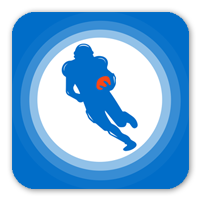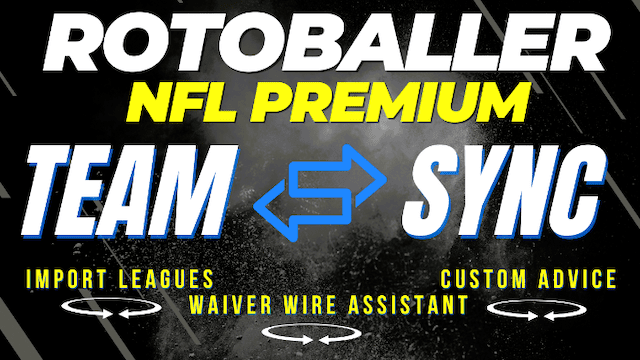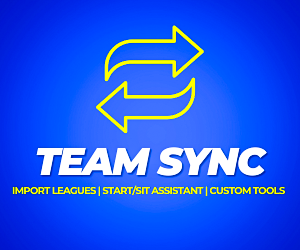Rob's tight end fantasy football start 'em, sit 'em picks for Week 7 of the 2025 season. Who should I start at tight end for fantasy football in Week 7 lineups?
Week 7 should bring the return of George Kittle, which should be a major boost to many fantasy lineups that have been waiting for him. The tight-end position lacks elite options, so losing Kittle was surely a big blow. This week, fantasy managers will need to adjust to Dalton Kincaid being on a bye.
Brock Bowers will surely be out another week. The Raiders are on bye in Week 8, so he'll get another couple of weeks of rest by missing Week 7. David Njoku may also be out this week, which might be another hurdle fantasy managers need to manage.
This article will also be posted to Reddit. If you have a question about a particular tight end or would like me to review one, please feel free to stop by and let me know. Please be sure to use the promo code "BOOM" to receive a 10% discount on any of our premium subscriptions.
Be sure to check all of our fantasy football rankings for 2025:- 2025 fantasy football rankings
- Running back (RB) rankings
- Wide receiver (WR) rankings
- Quarterback (QB) rankings
- Tight end (TE) rankings
- Defense (D/ST) rankings
- Kicker (K) rankings
- FLEX rankings
- Dynasty rankings
Mark Andrews vs. Isaiah Likely
Full disclosure: We need to be careful about drawing any significant conclusions from the last three weeks, given Lamar Jackson's absence. However, they are the first three weeks of the season that Likely and Andrews have shared the field since Likely returned from missing the first three weeks of the year.
Going from Jackson to Cooper Rush is sure to alter a team's offense, which is something we need to consider when evaluating these two players.
In Weeks 1-3, Andrews' route share was 69.9%. Despite this, Andrews managed only 10 targets, so even though Andrews was running a decent number of snaps, he wasn't getting many targets. His target share was just 13.2% over these first three weeks when Likely was inactive.
From Weeks 4-6, we saw a drastic change in Andrews' route share. His 69.9% rate dropped to 61.4% while Likely's was right behind at 59.4%. For Andrews, that's a significant problem. Fewer routes almost always mean fewer targets, and fewer targets mean fewer fantasy points. In this particular case, however, Andrews' target share actually rose to 19.5%, resulting in 17 targets.
Eight of those 17 targets came in Week 4, Likely's first game back. Despite it being his first game, Likely still had a 47.5% route share compared to Andrews' 57.5%. Likely did not draw a target, while Andrews posted his best weekly target share (24.2%) of the season.
In Week 5, Andrews had a 52.4% route share. He finished with three targets. Likely had a 42.9% route share and one target. Week 6 brought a fairly drastic change. While Andrews' route share rose to 70.0%, Likely's grew even more, surpassing even Andrews. He finished with an 80.0% route share. Now, Andrews still out-targeted Likely, four to two, but the switch in route share is worth noting.
This is especially true, given ESPN NFL insider Adam Schefter's indication that Andrews could be made available via trade. Andrews' production has waned lately, even dating back to last season. While he ran hot on touchdowns in 2024, he had the fewest targets, catches, and yards in any season in which he played over 10 games since his rookie season.
This committee will be one to watch once Jackson returns in Week 8. The Ravens are on bye this week, but Likely could be someone to stash given the fantasy implications an Andrews trade would have.
Is Sam LaPorta Back?
In Weeks 1-4 of the 2024 season, LaPorta was the TE17 with a 5.2 half-PPR PPG average. From Weeks 5-18, his half-PPR PPG increased to 10.3, ranking as the TE7 during that stretch. This season, LaPorta averaged 6.4 half-PPR PPG and was the TE18 in Weeks 1-4.
However, over the past two weeks, LaPorta has scored 17.7 and 14.0 half-PPR PPG, averaging 15.9, and has been the TE1. Does this mean LaPorta is back and can be trusted once again?
In truth, he could always be trusted. The first four weeks were simply the nature of the beast at the tight-end position. That and a loaded Detroit offense, where some of the guys behind Amon-Ra St. Brown and Jahmyr Gibbs will have down weeks.
| Time | Route Share | Target Share | Target Rate | TPG | RPG | RYPG | YPRR | YPR | YPT | aDot | x-Half-PPR PPG |
| Weeks 1-4 | 76.6% | 17.2% | 26% | 5.3 | 4.0 | 44.3 | 1.81 | 11.0 | 8.4 | 6.0 | 8.0 |
| Weeks 5-6 | 78.0% | 22.6% | 21% | 6.0 | 5.0 | 73.5 | 3.20 | 14.7 | 12.2 | 5.9 | 10.3 |
While LaPorta's target share increased, his target volume remained largely unchanged, increasing from 5.3 to just 6.0 targets per game. The biggest change has been the clear increase in his efficiency. With such two extremes, the truth often lies somewhere in the middle.
His expected half-PPR PPG in Weeks 1-4 was 8.0. This only rose to 10.3 in Weeks 5-6. This doesn't explain how his actual half-PPR PPG average could jump from 6.4 in Weeks 1-4 to 15.9 in Weeks 5-6. He was underperforming early and has recently overperformed. While fantasy managers shouldn't expect LaPorta to play as the TE1 he's been the past two weeks, they also shouldn't expect him to play as the TE18 he was the first four weeks.
Fantasy managers should view LaPorta as the mid TE1 they drafted a few months ago. LaPorta has a history of being a slow starter. He also has a history of being an incredibly effective and valuable fantasy asset. Fantasy managers should trust in that. Is LaPorta back? That depends on whether you ever thought he was gone. He was just in a little slumber, but he has awoken.
Can We Trust AJ Barner?
Barner is currently averaging 8.9 half-PPR PPG and is the TE12. Barner has scored more than 8.5 half-PPR points in four out of six games. This includes a 20.8 half-PPR point outing in Week 5. That sounds terrific, but will that continue? Barner scored 9.8, 10.7, and 8.6 half-PPR points in three contests, never finishing with more than three targets in any of them. Two of the three required Barner to find the end zone.
That's six. Just like that ‼️
📺: @NFLonPrime pic.twitter.com/eUgwVMKM3Q
— Seattle Seahawks (@Seahawks) September 26, 2025
Barner finished with fewer than 35 yards in each of his first four games of the year. He has only one game in which he finished with more than three targets. He has only one game with more than three receptions. Given those numbers, it's incredibly difficult to trust him, and yet, it's hard not to be infatuated.
Barner's route share stands at only 60.9%, limiting his target opportunities. As such, his target share is just 11.0%, good for just three targets per game. Barner has just an 8.9% share of Seattle's air yards. This aligns with his limited targets and downfield opportunities, which, in turn, limit his fantasy upside.
Could Barner be a red-zone maven, however? Through six weeks, Barner is tied for ninth among red-zone targets. He is tied for seventh among tight ends in targets inside the 10-yard line, and he has one end-zone target. While he has a role near the end zone, fantasy managers cannot trust Barner in their starting lineups regularly. However, he's played himself into streamer status and should be on fantasy managers' radars.
Harold Fannin Jr. is a Top-10 Tight End until David Njoku Returns
Fannin is the TE17 with a 7.6 half-PPR PPG through six weeks. He has two top-12 finishes and has very much looked the part of a fantasy-relevant tight end. However, at this time, he's being held back by a few circumstances outside of his control. First, the quarterback play and offensive efficiency have been poor. This negatively affects his ceiling. The other is the presence of David Njoku, who has limited his route and opportunity usage.
Njoku struggled with a knee injury in Week 6, and that led to some of the best underlying metrics of the year for Fannin. He played 81% of the snaps, and while this didn't eclipse a season-high, it was just the second time he was above 80% all year. Fannin did, however, set career highs in route percentage (74.1%) and targets (10). For the season, Fannin's route share stands at 59.5%. This has been the primary reason his fantasy production has been held back.
Due to a lack of routes, Fannin's target share is just 14.9%, but his target rate is 23.0%. When he's running routes, he's earning targets. If Njoku misses Week 7, which appears to be the expectation at this time, Fannin immediately becomes a top-10 tight end. This is especially true with a matchup with the Miami Dolphins on tap. They are allowing the sixth-most fantasy points to opposing tight ends this season. Fannin is a must-start this week.
What's Going On With Hunter Henry?
Over the first three weeks, Henry averaged 11.6 half-PPR PPG. His expected half-PPR PPG over this span was 15.4. He had 22 targets, averaging just over seven per game. From Weeks 4-6, however, Henry's half-PPR PPG average has dipped to 6.9, aligning almost perfectly with his expected half-PPR PPG average of 6.8 over this span. He has just nine targets, averaging three per game. In Week 1, he had eight, and in Week 3, he had 11.
| Time | Route Share | Target Share | Target Rate | Air Yard Share |
| Weeks 1-3 | 69.2% | 19.8% | 23.0% | 29.2% |
| Weeks 4-6 | 69.7% | 12.2% | 15.0% | 13.6% |
His yard per route run average has remained steady, with a 1.83 in Weeks 1-3 and 1.81 in Weeks 4-6. So, what do we make of the change? Henry's route share and efficiency have remained consistent, but his volume has dipped. While his air yard share also looks like a drastic change, this is largely driven by volume because his average depth of target remains completely unchanged. In Weeks 1-3, this stood at 9.8, and in Weeks 4-6, it was 9.7.
Henry's downward trend began right as Stefon Diggs's upward trajectory began. It was in Week 4 that Diggs had seven targets, six receptions, and 101 yards. Then in Week 5, he had 12 targets, 10 receptions, and 146 yards. Has the offense shifted away from featuring Henry? Looking at Henry's first-read target share, it seems there's some truth to this theory.
In Weeks 1-3, Henry's first-read target share was 22.5%. In Weeks 4-6, this dipped to 15.6%. If the team is going to continue to feature Diggs over Henry, then fantasy managers need to adjust their opinion on Henry's fantasy value. Given Henry's last couple of years and his age, expecting Henry's Week 1-3 play to continue may have been too optimistic.
Henry's 9.8 average depth of target is encouraging, however. However, given his limited volume, Henry will continue to be a boom-or-bust option. However, given that the team is targeting him further down the field than other tight ends and that he has a presence near the goal line, there will be weeks when Henry pops. Fantasy managers should just view him as a strong TE2 who can be an excellent streamer as opposed to a weekly starter.
Week 7 Rankings
1. Trey McBride vs. Green Bay
2. Sam LaPorta vs. Tampa Bay
3. Tyler Warren at Los Angeles Chargers
4. Jake Ferguson vs. Washington
5. Tucker Kraft at Arizona
6. George Kittle vs. Atlanta
7. Dallas Goedert at Minnesota
8. Harold Fannin Jr. vs. Miami
9. Cade Otton at Detroit
10. Darren Waller at Cleveland
11. Zach Ertz at Dallas
12. Travis Kelce vs. Las Vegas
13. Kyle Pitts Sr. at San Francisco
14. Michael Mayer at Kansas City
15. Hunter Henry at Tennessee
16. T.J. Hockenson vs. Philadelphia
17. Mason Taylor vs. Carolina
18. Oronde Gadsden II vs. Indianapolis
19. Chig Okonkwo vs. New England
20. Evan Engram vs. New York Giants
21. Theo Johnson at Denver
22. AJ Barner vs. Houston
23. Noah Fant vs. Pittsburgh
24. Jonnu Smith at Cincinnati
25. Juwan Johnson at Chicago
More Fantasy Football Analysis
Download Our Free News & Alerts Mobile App
Like what you see? Download our updated fantasy football app for iPhone and Android with 24x7 player news, injury alerts, rankings, starts/sits & more. All free!






 RADIO
RADIO
























